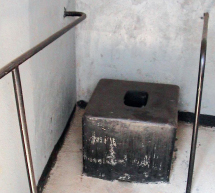12.1.1 Provision of improved latrines
The provision of improved latrines with attached urinals in schools is extremely important. Many of the design requirements are similar to those for domestic latrines that you learned about in Study Session 5. For example, latrines must be located a safe distance from water sources. The government guidance for schools includes the following additional requirements:
- There should be separate latrine blocks for boys and girls that are located away from each other in the school compound. They should be near enough to the classrooms to be convenient for use but not so close that odour is a problem. The location, design and construction must provide privacy and security. Hedges can be used as screens between girls’ and boys’ latrine blocks. Latrines for male and female teachers must be separated as well.
- Latrines must be easy to clean, well maintained and agreeable to use.
- The number of squat holes (cubicles) should be proportional to the number of students and take account of any future increase in school population. The recommended ratio is at least one cubicle per 100 students. All schools, regardless of size, should have a minimum of two cubicles for girls and two for boys. Using appropriately designed urinals for boys and men can reduce the total number of cubicles required.
- Facilities should be designed to be appropriate for the size of children in the school. For example, for young children door handles and wash basins need to be lower.
- Each latrine block should have one cubicle that is accessible to students with disabilities including those who use a wheelchair (Figure 12.1). This should have additional space inside, handrails, a raised seat and an access ramp.
- Handwashing facilities must be provided for boys and girls.

In Study Session 5, you learned of the different types of latrine technologies. Which of them do you think could be used in schools?
Schools could use improved pit latrines or VIP latrines (with lined pit, concrete slab and vent pipe). They could use composting toilets or urine-diverting toilets if they had the necessary equipment, staff and procedures in place. Pour-flush latrines or cistern-flush toilets are also possible if there was access to water and connection to a septic tank or sewer.
12.1 Sanitation and waste management in schools
